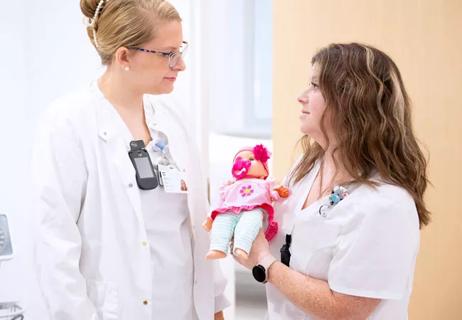Patient’s favorite food helps guide decisions regarding end-of-life interventions

An 80-year-old, fully dependent, Spanish-speaking woman with a history of severe dementia was admitted to the intensive care unit (ICU) with septic shock caused by Methicillin-resistant Staphylococcus aureus and possible endocarditis. She required broad-spectrum antibiotics, intravenous pressors, and placement of a nasogastric tube due to severe dysphagia.
Advertisement
Cleveland Clinic is a non-profit academic medical center. Advertising on our site helps support our mission. We do not endorse non-Cleveland Clinic products or services. Policy
After 5 days in the ICU, the patient was transferred to the general medicine floor, where she remained in hypoactive delirium. Multiple discussions were held between the admitting clinical team and the woman’s daughter – her healthcare surrogate – regarding code status and the need for invasive procedures (e.g., transesophageal echocardiogram and percutaneous endoscopic gastrostomy [PEG] tube placement). Because the daughter refused to consider palliative care, the geriatric team was consulted to extend the goals-of-care discussion.
This case highlights the importance of identifying what matters most to older patients through conversations regarding goals of care, explains Cleveland Clinic geriatrician Juan Carlos Nunez, MD. Ideally, these discussions should occur in the presence of both the patient and their caregivers, allowing ample time to exchange information and correct any misconceptions, he says.
“During a patient’s first visit, I always ask what’s most important to them at this point in time,” he says. “These conversations can provide invaluable insights about who the patient was before they became sick, who they are now and what their life might look like in the future. Those personal goals can then be used to help guide key decisions about the patient’s healthcare.”
Although most relatively healthy patients will list priorities like the well-being of their family, the ability to travel or being present at a grandchild’s college graduation, explains Dr. Nunez, inpatients and their families may have other, more modest goals. For older adults nearing the end of life, considerations like resuscitation orders, mechanical ventilation and parenteral nutrition are often top of mind.
Advertisement
To help guide such decisions, Dr. Nunez and his team use the Institute for Healthcare Improvements 4M Framework for Age-Friendly Health Systems: What matters most, medication, mentation and mobility.
“As physicians, we’re trained to save lives with medications and procedures, but it’s so essential to stop and ask: How does the patient feel about receiving these treatments?” he says. “Being a successful caregiver in the truest sense of the word requires us to align our priorities with those of patients and their families.”
The patient’s daughter was asked to meet with the geriatric team in person to discuss her concerns and expectations regarding her mother’s health. Given the patient’s severe dementia and swallowing concerns, all agreed that her nourishment was what mattered most, so the geriatric team encouraged the daughter to offer her mother’s favorite food, papas fritas (French fries). Following the discussion, the woman’s daughter declined PEG tube placement, signed a do-not-resuscitate order and accepted a hospice consult.
The case, which was presented at the Presidential ePoster Session of the 2024 annual meeting of the American Geriatrics Society, highlights the importance of candid conversations around each patient’s capabilities, personal priorities and prognosis, says Dr. Nunez. Although such discussions can be challenging, patients and families are “almost universally grateful for the opportunity to talk these things through,” he adds.
“Once the family in this case understood the risks and limited benefits of placing a feeding tube, the conversation turned to what foods the patient could actually enjoy,” he says. “By having an open, honest conversation focused on the patient as whole person, we found something quite simple that could give her pleasure in her final days.”
Advertisement
Advertisement

Depression, agitation, delusions and more compound challenges for patients and caregivers

Study provides Class III evidence that assay distinguishes disease from normal controls

Pilot study confirms feasibility of conducting additional research on the novel treatment

Patients benefit when doctors disclose with care

New findings have important implications for clinical trial design

Novel Cleveland Clinic project is fueled by a $1 million NIH grant

Large NIH-funded investigation is exploring this understudied phenomenon

Cleveland Clinic pioneers a new paradigm in cardiovascular care delivery